An Overview: Benefits and Challenges of Business Process Management
VerifiedAdded on 2023/06/07
|10
|2013
|110
Report
AI Summary
This report provides an in-depth analysis of Business Process Management (BPM), highlighting its benefits and challenges. It explores BPM's role in enhancing business operations through process strategy, architecture, ownership, and optimization. The report also addresses the challenges of BPM implementation and introduces Business Process Blueprinting (BP2) as a method to improve customer-company relationships and overall process performance. It discusses the aspects that must be considered for successful BPM implementation and the limitations of BP2 while emphasizing its potential to become a key component in modern business process management. The report concludes that BPM is crucial for commercial success and that BP2 will add value to BPM.
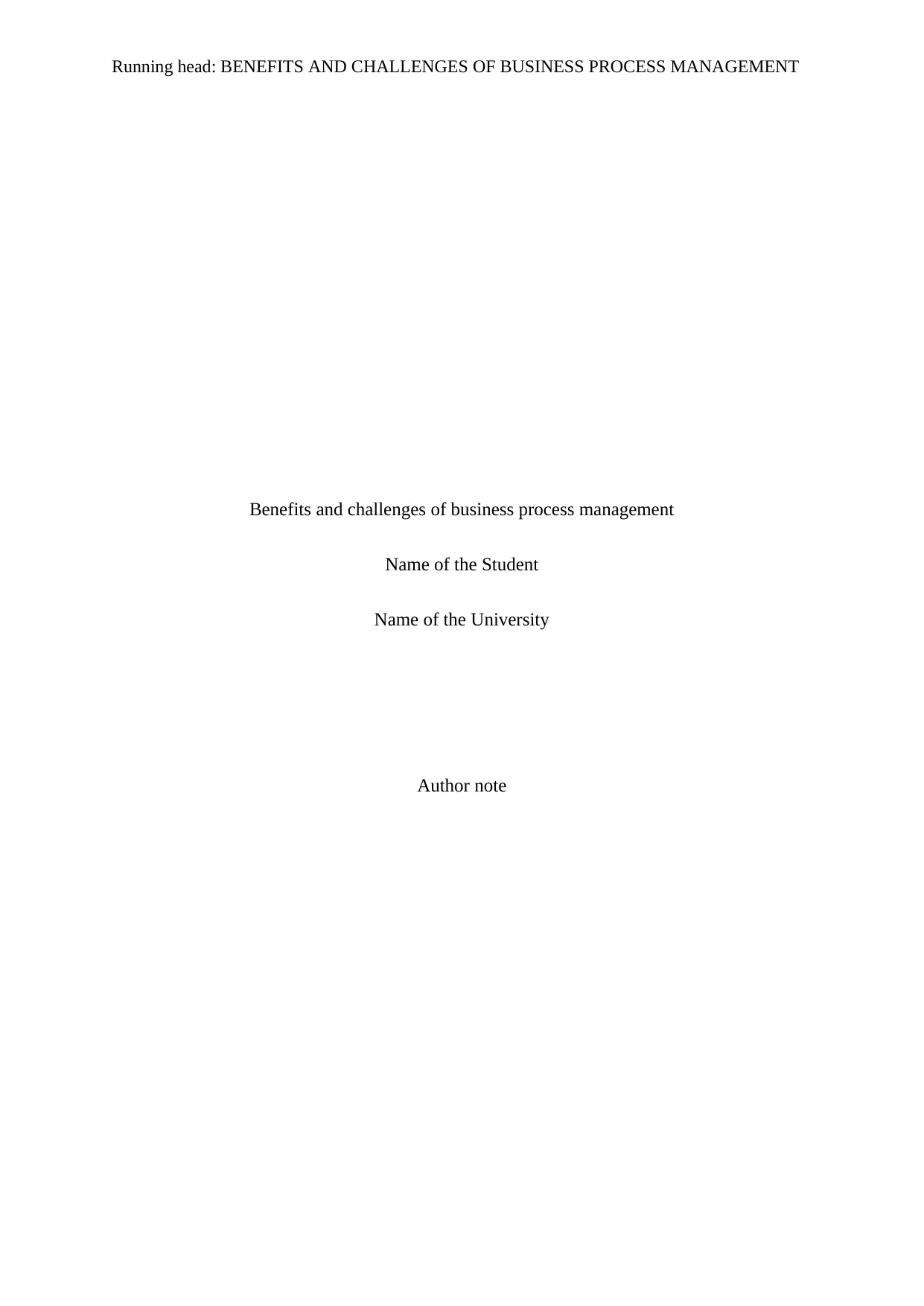
Running head: BENEFITS AND CHALLENGES OF BUSINESS PROCESS MANAGEMENT
Benefits and challenges of business process management
Name of the Student
Name of the University
Author note
Benefits and challenges of business process management
Name of the Student
Name of the University
Author note
Paraphrase This Document
Need a fresh take? Get an instant paraphrase of this document with our AI Paraphraser
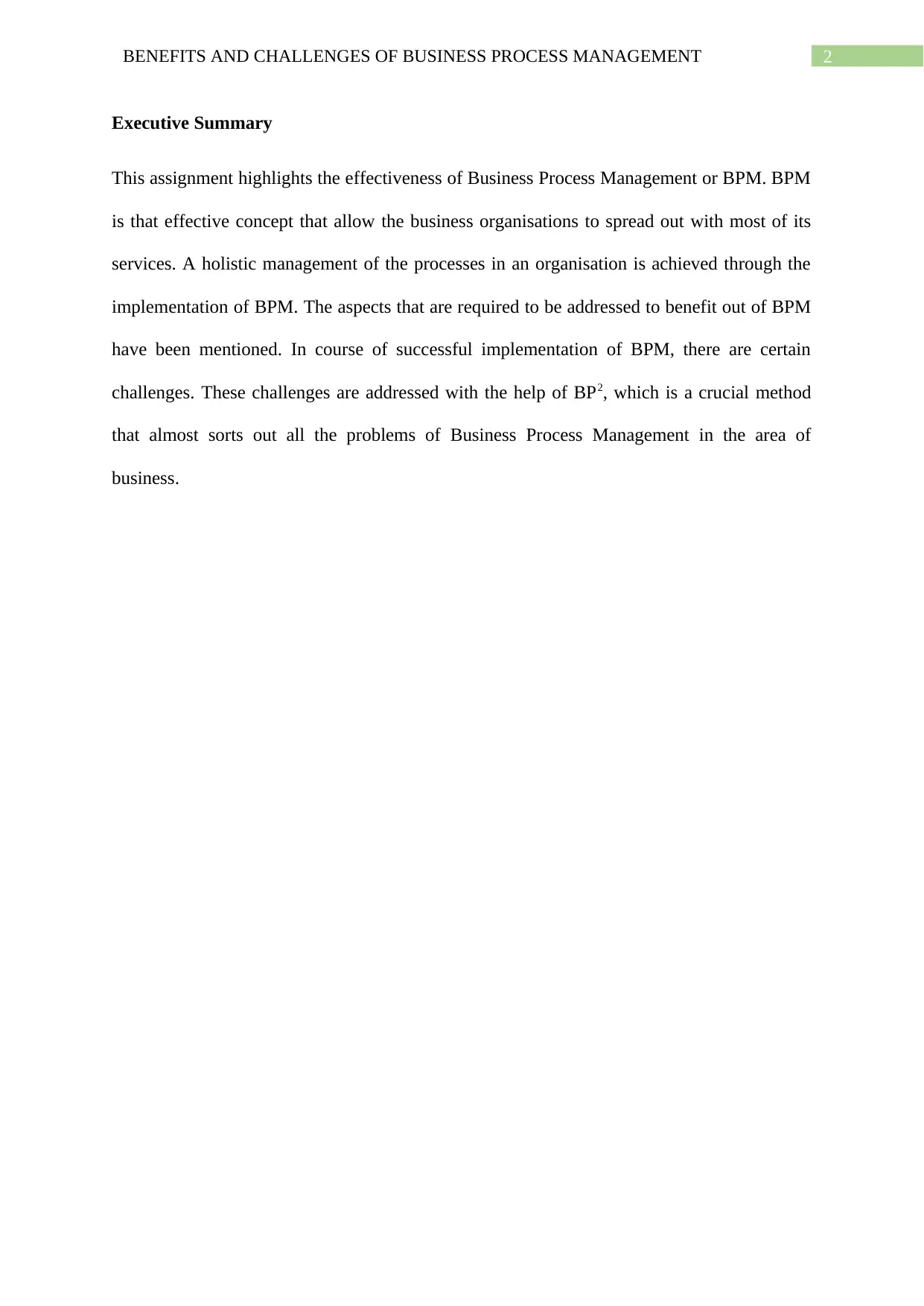
2BENEFITS AND CHALLENGES OF BUSINESS PROCESS MANAGEMENT
Executive Summary
This assignment highlights the effectiveness of Business Process Management or BPM. BPM
is that effective concept that allow the business organisations to spread out with most of its
services. A holistic management of the processes in an organisation is achieved through the
implementation of BPM. The aspects that are required to be addressed to benefit out of BPM
have been mentioned. In course of successful implementation of BPM, there are certain
challenges. These challenges are addressed with the help of BP2, which is a crucial method
that almost sorts out all the problems of Business Process Management in the area of
business.
Executive Summary
This assignment highlights the effectiveness of Business Process Management or BPM. BPM
is that effective concept that allow the business organisations to spread out with most of its
services. A holistic management of the processes in an organisation is achieved through the
implementation of BPM. The aspects that are required to be addressed to benefit out of BPM
have been mentioned. In course of successful implementation of BPM, there are certain
challenges. These challenges are addressed with the help of BP2, which is a crucial method
that almost sorts out all the problems of Business Process Management in the area of
business.
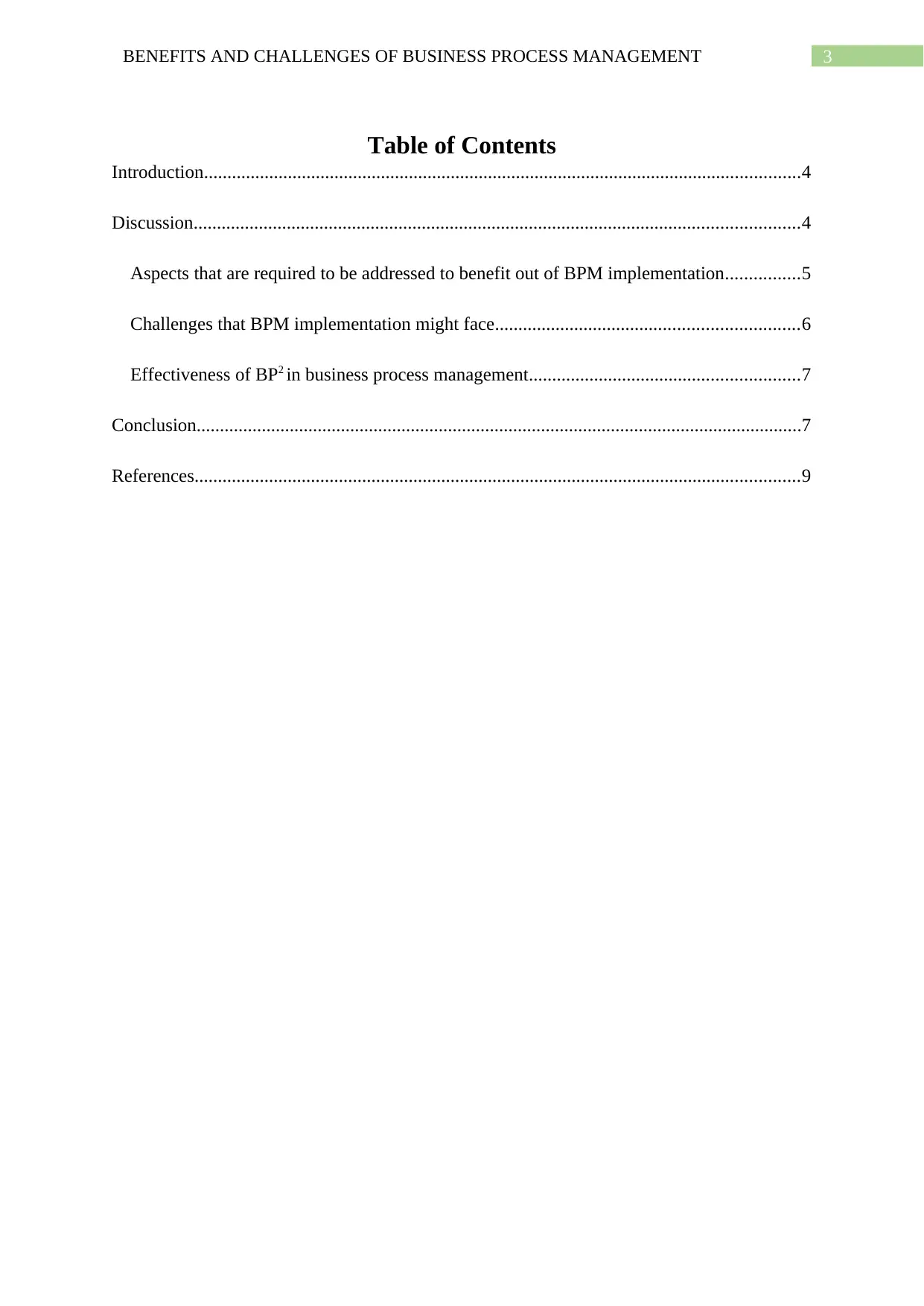
3BENEFITS AND CHALLENGES OF BUSINESS PROCESS MANAGEMENT
Table of Contents
Introduction................................................................................................................................4
Discussion..................................................................................................................................4
Aspects that are required to be addressed to benefit out of BPM implementation................5
Challenges that BPM implementation might face.................................................................6
Effectiveness of BP2 in business process management..........................................................7
Conclusion..................................................................................................................................7
References..................................................................................................................................9
Table of Contents
Introduction................................................................................................................................4
Discussion..................................................................................................................................4
Aspects that are required to be addressed to benefit out of BPM implementation................5
Challenges that BPM implementation might face.................................................................6
Effectiveness of BP2 in business process management..........................................................7
Conclusion..................................................................................................................................7
References..................................................................................................................................9
⊘ This is a preview!⊘
Do you want full access?
Subscribe today to unlock all pages.

Trusted by 1+ million students worldwide
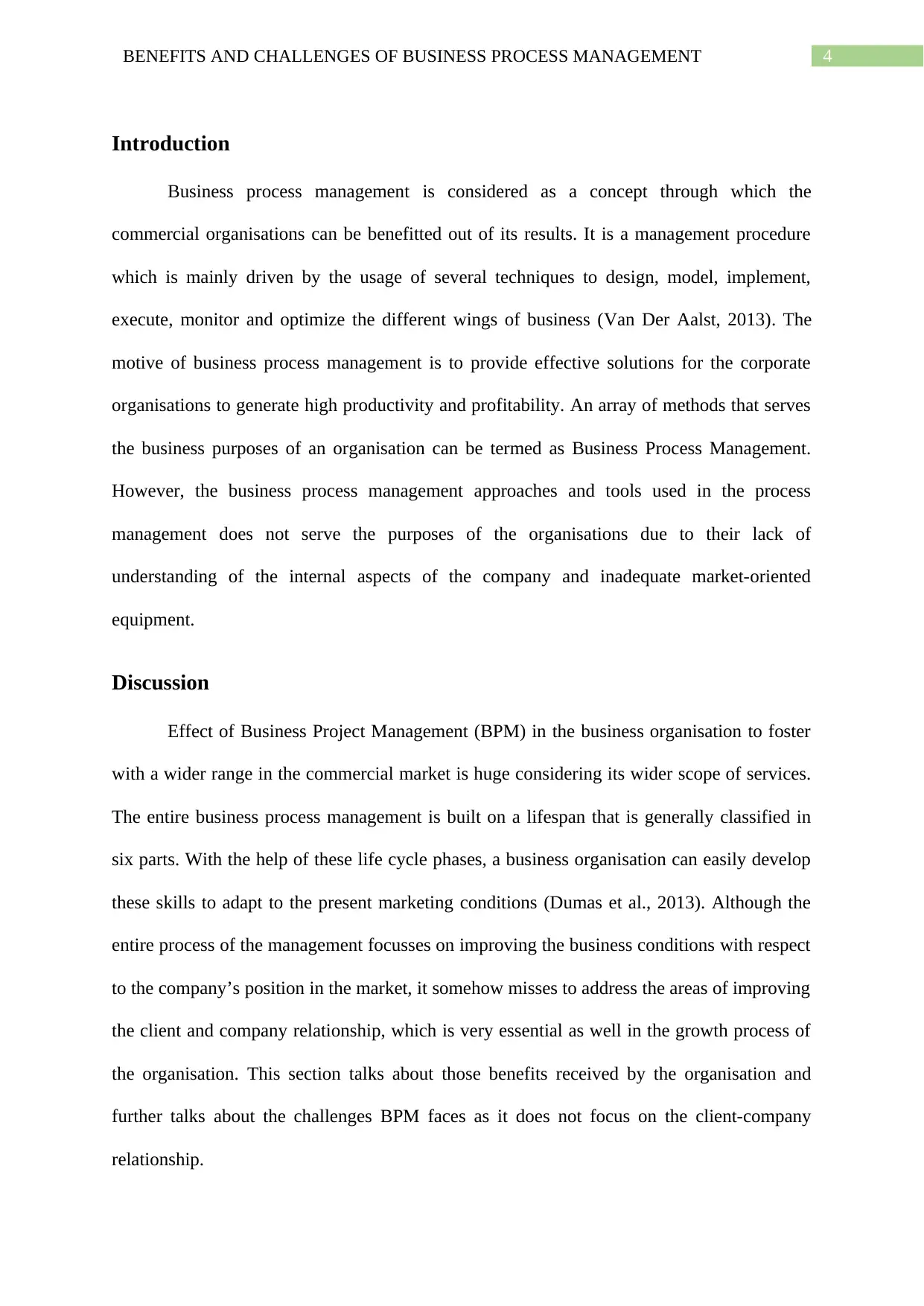
4BENEFITS AND CHALLENGES OF BUSINESS PROCESS MANAGEMENT
Introduction
Business process management is considered as a concept through which the
commercial organisations can be benefitted out of its results. It is a management procedure
which is mainly driven by the usage of several techniques to design, model, implement,
execute, monitor and optimize the different wings of business (Van Der Aalst, 2013). The
motive of business process management is to provide effective solutions for the corporate
organisations to generate high productivity and profitability. An array of methods that serves
the business purposes of an organisation can be termed as Business Process Management.
However, the business process management approaches and tools used in the process
management does not serve the purposes of the organisations due to their lack of
understanding of the internal aspects of the company and inadequate market-oriented
equipment.
Discussion
Effect of Business Project Management (BPM) in the business organisation to foster
with a wider range in the commercial market is huge considering its wider scope of services.
The entire business process management is built on a lifespan that is generally classified in
six parts. With the help of these life cycle phases, a business organisation can easily develop
these skills to adapt to the present marketing conditions (Dumas et al., 2013). Although the
entire process of the management focusses on improving the business conditions with respect
to the company’s position in the market, it somehow misses to address the areas of improving
the client and company relationship, which is very essential as well in the growth process of
the organisation. This section talks about those benefits received by the organisation and
further talks about the challenges BPM faces as it does not focus on the client-company
relationship.
Introduction
Business process management is considered as a concept through which the
commercial organisations can be benefitted out of its results. It is a management procedure
which is mainly driven by the usage of several techniques to design, model, implement,
execute, monitor and optimize the different wings of business (Van Der Aalst, 2013). The
motive of business process management is to provide effective solutions for the corporate
organisations to generate high productivity and profitability. An array of methods that serves
the business purposes of an organisation can be termed as Business Process Management.
However, the business process management approaches and tools used in the process
management does not serve the purposes of the organisations due to their lack of
understanding of the internal aspects of the company and inadequate market-oriented
equipment.
Discussion
Effect of Business Project Management (BPM) in the business organisation to foster
with a wider range in the commercial market is huge considering its wider scope of services.
The entire business process management is built on a lifespan that is generally classified in
six parts. With the help of these life cycle phases, a business organisation can easily develop
these skills to adapt to the present marketing conditions (Dumas et al., 2013). Although the
entire process of the management focusses on improving the business conditions with respect
to the company’s position in the market, it somehow misses to address the areas of improving
the client and company relationship, which is very essential as well in the growth process of
the organisation. This section talks about those benefits received by the organisation and
further talks about the challenges BPM faces as it does not focus on the client-company
relationship.
Paraphrase This Document
Need a fresh take? Get an instant paraphrase of this document with our AI Paraphraser
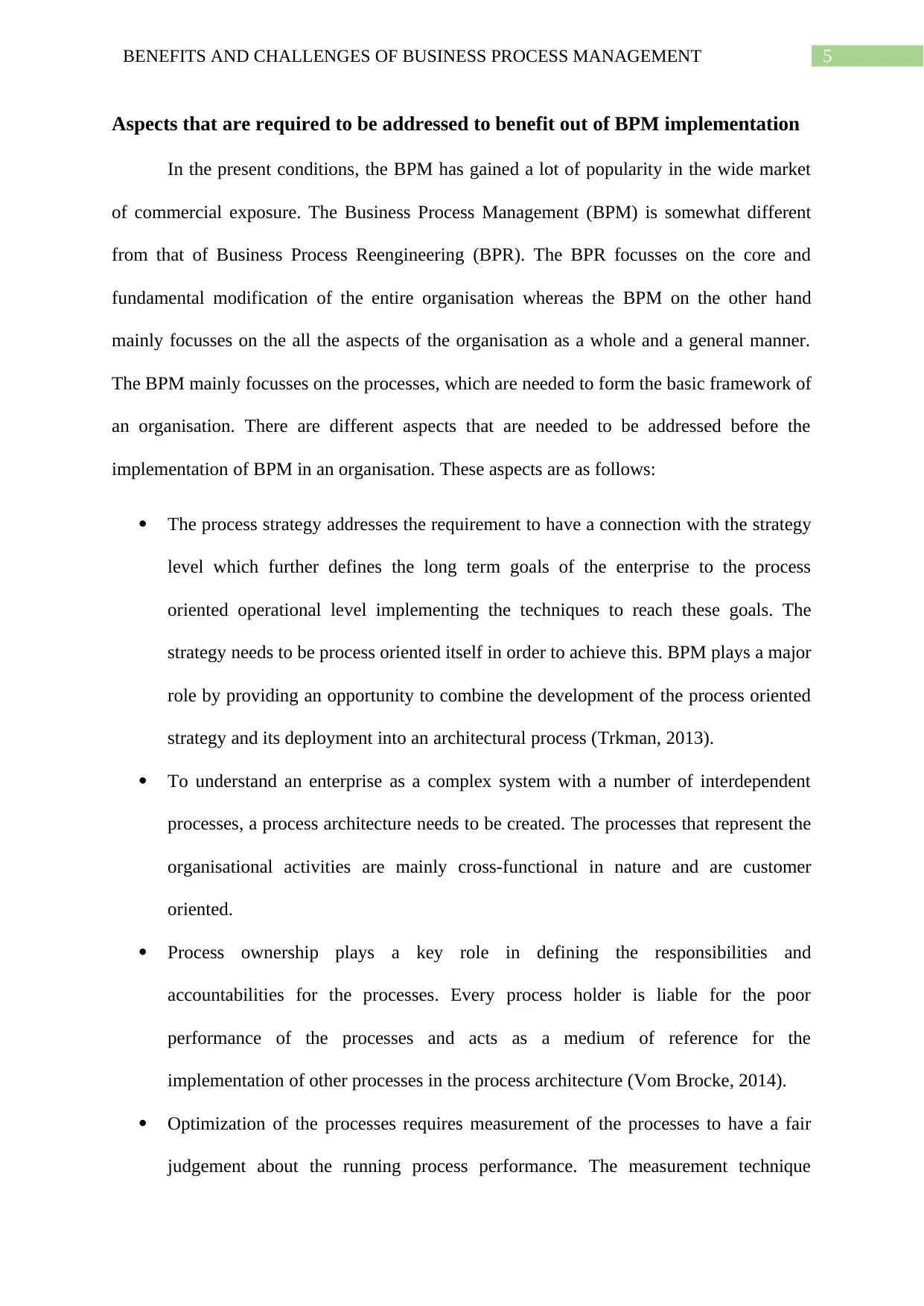
5BENEFITS AND CHALLENGES OF BUSINESS PROCESS MANAGEMENT
Aspects that are required to be addressed to benefit out of BPM implementation
In the present conditions, the BPM has gained a lot of popularity in the wide market
of commercial exposure. The Business Process Management (BPM) is somewhat different
from that of Business Process Reengineering (BPR). The BPR focusses on the core and
fundamental modification of the entire organisation whereas the BPM on the other hand
mainly focusses on the all the aspects of the organisation as a whole and a general manner.
The BPM mainly focusses on the processes, which are needed to form the basic framework of
an organisation. There are different aspects that are needed to be addressed before the
implementation of BPM in an organisation. These aspects are as follows:
The process strategy addresses the requirement to have a connection with the strategy
level which further defines the long term goals of the enterprise to the process
oriented operational level implementing the techniques to reach these goals. The
strategy needs to be process oriented itself in order to achieve this. BPM plays a major
role by providing an opportunity to combine the development of the process oriented
strategy and its deployment into an architectural process (Trkman, 2013).
To understand an enterprise as a complex system with a number of interdependent
processes, a process architecture needs to be created. The processes that represent the
organisational activities are mainly cross-functional in nature and are customer
oriented.
Process ownership plays a key role in defining the responsibilities and
accountabilities for the processes. Every process holder is liable for the poor
performance of the processes and acts as a medium of reference for the
implementation of other processes in the process architecture (Vom Brocke, 2014).
Optimization of the processes requires measurement of the processes to have a fair
judgement about the running process performance. The measurement technique
Aspects that are required to be addressed to benefit out of BPM implementation
In the present conditions, the BPM has gained a lot of popularity in the wide market
of commercial exposure. The Business Process Management (BPM) is somewhat different
from that of Business Process Reengineering (BPR). The BPR focusses on the core and
fundamental modification of the entire organisation whereas the BPM on the other hand
mainly focusses on the all the aspects of the organisation as a whole and a general manner.
The BPM mainly focusses on the processes, which are needed to form the basic framework of
an organisation. There are different aspects that are needed to be addressed before the
implementation of BPM in an organisation. These aspects are as follows:
The process strategy addresses the requirement to have a connection with the strategy
level which further defines the long term goals of the enterprise to the process
oriented operational level implementing the techniques to reach these goals. The
strategy needs to be process oriented itself in order to achieve this. BPM plays a major
role by providing an opportunity to combine the development of the process oriented
strategy and its deployment into an architectural process (Trkman, 2013).
To understand an enterprise as a complex system with a number of interdependent
processes, a process architecture needs to be created. The processes that represent the
organisational activities are mainly cross-functional in nature and are customer
oriented.
Process ownership plays a key role in defining the responsibilities and
accountabilities for the processes. Every process holder is liable for the poor
performance of the processes and acts as a medium of reference for the
implementation of other processes in the process architecture (Vom Brocke, 2014).
Optimization of the processes requires measurement of the processes to have a fair
judgement about the running process performance. The measurement technique
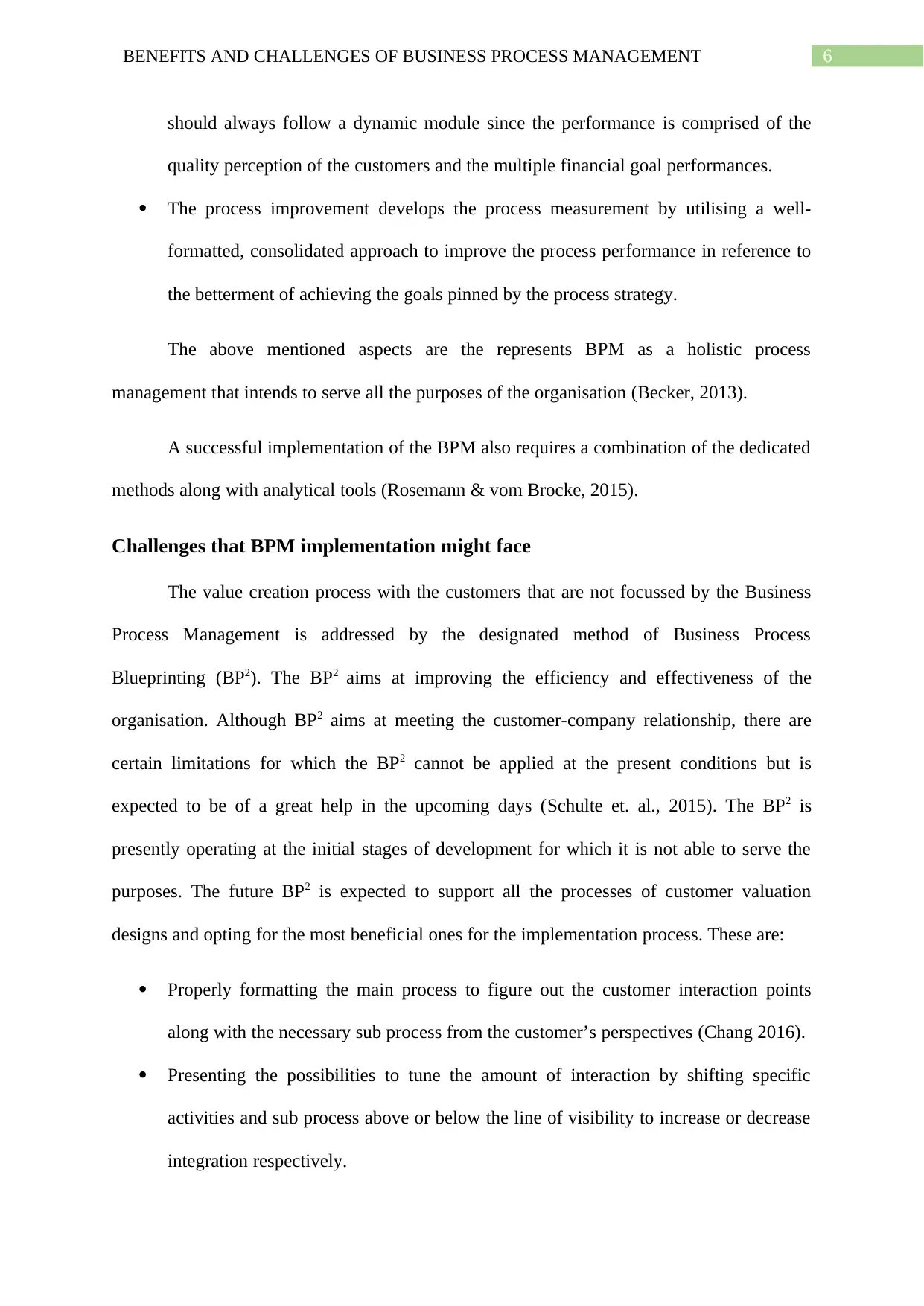
6BENEFITS AND CHALLENGES OF BUSINESS PROCESS MANAGEMENT
should always follow a dynamic module since the performance is comprised of the
quality perception of the customers and the multiple financial goal performances.
The process improvement develops the process measurement by utilising a well-
formatted, consolidated approach to improve the process performance in reference to
the betterment of achieving the goals pinned by the process strategy.
The above mentioned aspects are the represents BPM as a holistic process
management that intends to serve all the purposes of the organisation (Becker, 2013).
A successful implementation of the BPM also requires a combination of the dedicated
methods along with analytical tools (Rosemann & vom Brocke, 2015).
Challenges that BPM implementation might face
The value creation process with the customers that are not focussed by the Business
Process Management is addressed by the designated method of Business Process
Blueprinting (BP2). The BP2 aims at improving the efficiency and effectiveness of the
organisation. Although BP2 aims at meeting the customer-company relationship, there are
certain limitations for which the BP2 cannot be applied at the present conditions but is
expected to be of a great help in the upcoming days (Schulte et. al., 2015). The BP2 is
presently operating at the initial stages of development for which it is not able to serve the
purposes. The future BP2 is expected to support all the processes of customer valuation
designs and opting for the most beneficial ones for the implementation process. These are:
Properly formatting the main process to figure out the customer interaction points
along with the necessary sub process from the customer’s perspectives (Chang 2016).
Presenting the possibilities to tune the amount of interaction by shifting specific
activities and sub process above or below the line of visibility to increase or decrease
integration respectively.
should always follow a dynamic module since the performance is comprised of the
quality perception of the customers and the multiple financial goal performances.
The process improvement develops the process measurement by utilising a well-
formatted, consolidated approach to improve the process performance in reference to
the betterment of achieving the goals pinned by the process strategy.
The above mentioned aspects are the represents BPM as a holistic process
management that intends to serve all the purposes of the organisation (Becker, 2013).
A successful implementation of the BPM also requires a combination of the dedicated
methods along with analytical tools (Rosemann & vom Brocke, 2015).
Challenges that BPM implementation might face
The value creation process with the customers that are not focussed by the Business
Process Management is addressed by the designated method of Business Process
Blueprinting (BP2). The BP2 aims at improving the efficiency and effectiveness of the
organisation. Although BP2 aims at meeting the customer-company relationship, there are
certain limitations for which the BP2 cannot be applied at the present conditions but is
expected to be of a great help in the upcoming days (Schulte et. al., 2015). The BP2 is
presently operating at the initial stages of development for which it is not able to serve the
purposes. The future BP2 is expected to support all the processes of customer valuation
designs and opting for the most beneficial ones for the implementation process. These are:
Properly formatting the main process to figure out the customer interaction points
along with the necessary sub process from the customer’s perspectives (Chang 2016).
Presenting the possibilities to tune the amount of interaction by shifting specific
activities and sub process above or below the line of visibility to increase or decrease
integration respectively.
⊘ This is a preview!⊘
Do you want full access?
Subscribe today to unlock all pages.

Trusted by 1+ million students worldwide
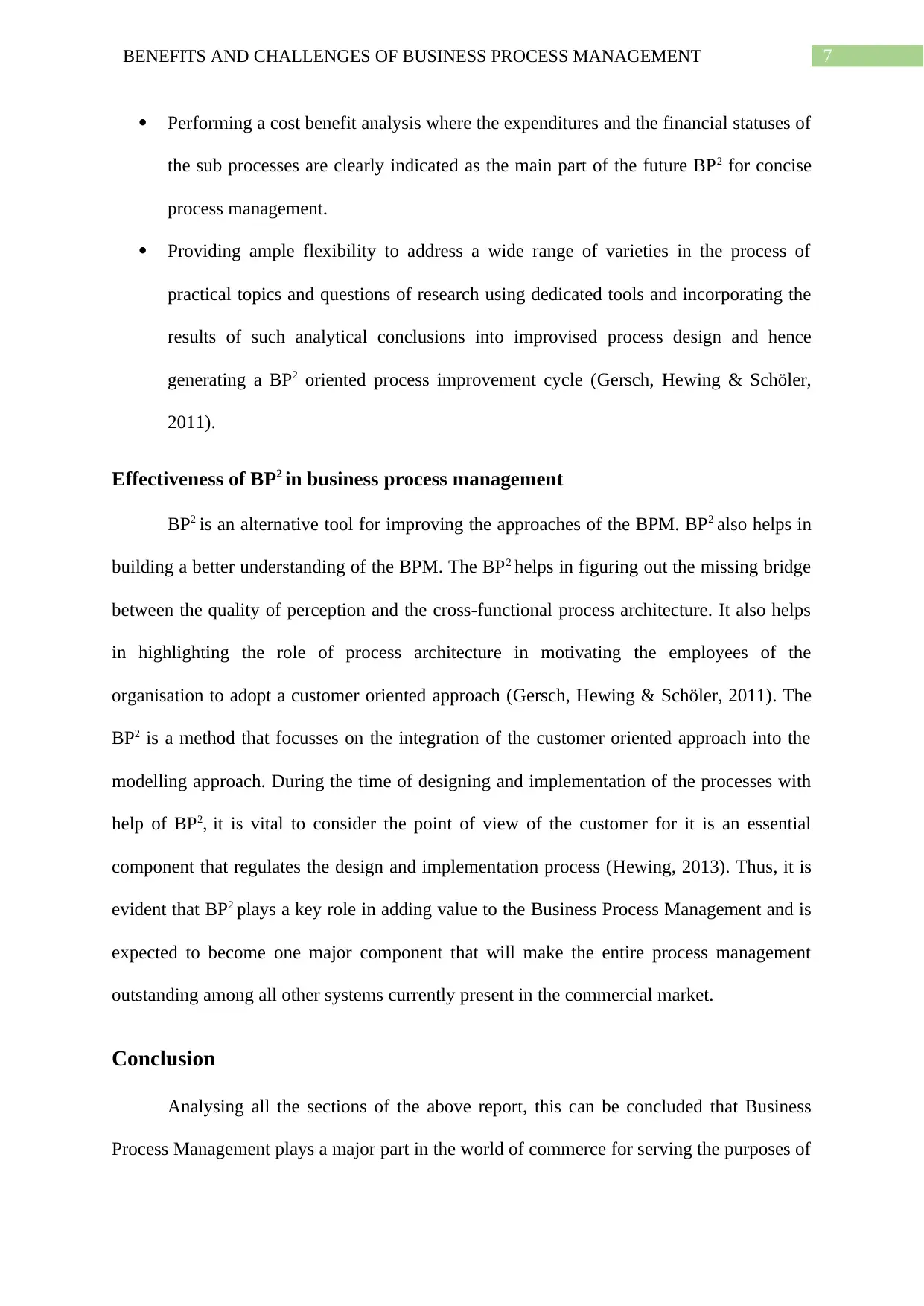
7BENEFITS AND CHALLENGES OF BUSINESS PROCESS MANAGEMENT
Performing a cost benefit analysis where the expenditures and the financial statuses of
the sub processes are clearly indicated as the main part of the future BP2 for concise
process management.
Providing ample flexibility to address a wide range of varieties in the process of
practical topics and questions of research using dedicated tools and incorporating the
results of such analytical conclusions into improvised process design and hence
generating a BP2 oriented process improvement cycle (Gersch, Hewing & Schöler,
2011).
Effectiveness of BP2 in business process management
BP2 is an alternative tool for improving the approaches of the BPM. BP2 also helps in
building a better understanding of the BPM. The BP2 helps in figuring out the missing bridge
between the quality of perception and the cross-functional process architecture. It also helps
in highlighting the role of process architecture in motivating the employees of the
organisation to adopt a customer oriented approach (Gersch, Hewing & Schöler, 2011). The
BP2 is a method that focusses on the integration of the customer oriented approach into the
modelling approach. During the time of designing and implementation of the processes with
help of BP2, it is vital to consider the point of view of the customer for it is an essential
component that regulates the design and implementation process (Hewing, 2013). Thus, it is
evident that BP2 plays a key role in adding value to the Business Process Management and is
expected to become one major component that will make the entire process management
outstanding among all other systems currently present in the commercial market.
Conclusion
Analysing all the sections of the above report, this can be concluded that Business
Process Management plays a major part in the world of commerce for serving the purposes of
Performing a cost benefit analysis where the expenditures and the financial statuses of
the sub processes are clearly indicated as the main part of the future BP2 for concise
process management.
Providing ample flexibility to address a wide range of varieties in the process of
practical topics and questions of research using dedicated tools and incorporating the
results of such analytical conclusions into improvised process design and hence
generating a BP2 oriented process improvement cycle (Gersch, Hewing & Schöler,
2011).
Effectiveness of BP2 in business process management
BP2 is an alternative tool for improving the approaches of the BPM. BP2 also helps in
building a better understanding of the BPM. The BP2 helps in figuring out the missing bridge
between the quality of perception and the cross-functional process architecture. It also helps
in highlighting the role of process architecture in motivating the employees of the
organisation to adopt a customer oriented approach (Gersch, Hewing & Schöler, 2011). The
BP2 is a method that focusses on the integration of the customer oriented approach into the
modelling approach. During the time of designing and implementation of the processes with
help of BP2, it is vital to consider the point of view of the customer for it is an essential
component that regulates the design and implementation process (Hewing, 2013). Thus, it is
evident that BP2 plays a key role in adding value to the Business Process Management and is
expected to become one major component that will make the entire process management
outstanding among all other systems currently present in the commercial market.
Conclusion
Analysing all the sections of the above report, this can be concluded that Business
Process Management plays a major part in the world of commerce for serving the purposes of
Paraphrase This Document
Need a fresh take? Get an instant paraphrase of this document with our AI Paraphraser
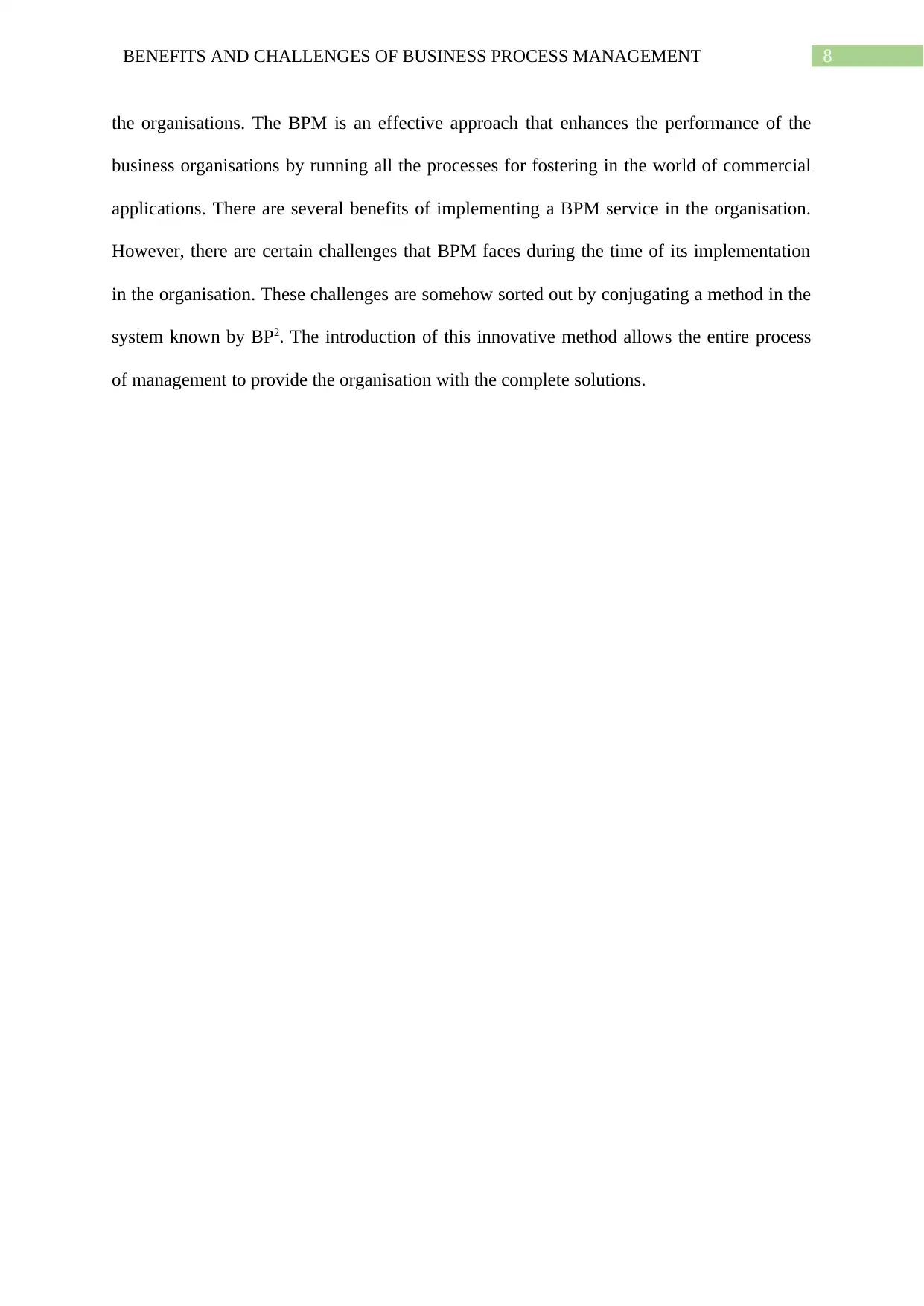
8BENEFITS AND CHALLENGES OF BUSINESS PROCESS MANAGEMENT
the organisations. The BPM is an effective approach that enhances the performance of the
business organisations by running all the processes for fostering in the world of commercial
applications. There are several benefits of implementing a BPM service in the organisation.
However, there are certain challenges that BPM faces during the time of its implementation
in the organisation. These challenges are somehow sorted out by conjugating a method in the
system known by BP2. The introduction of this innovative method allows the entire process
of management to provide the organisation with the complete solutions.
the organisations. The BPM is an effective approach that enhances the performance of the
business organisations by running all the processes for fostering in the world of commercial
applications. There are several benefits of implementing a BPM service in the organisation.
However, there are certain challenges that BPM faces during the time of its implementation
in the organisation. These challenges are somehow sorted out by conjugating a method in the
system known by BP2. The introduction of this innovative method allows the entire process
of management to provide the organisation with the complete solutions.
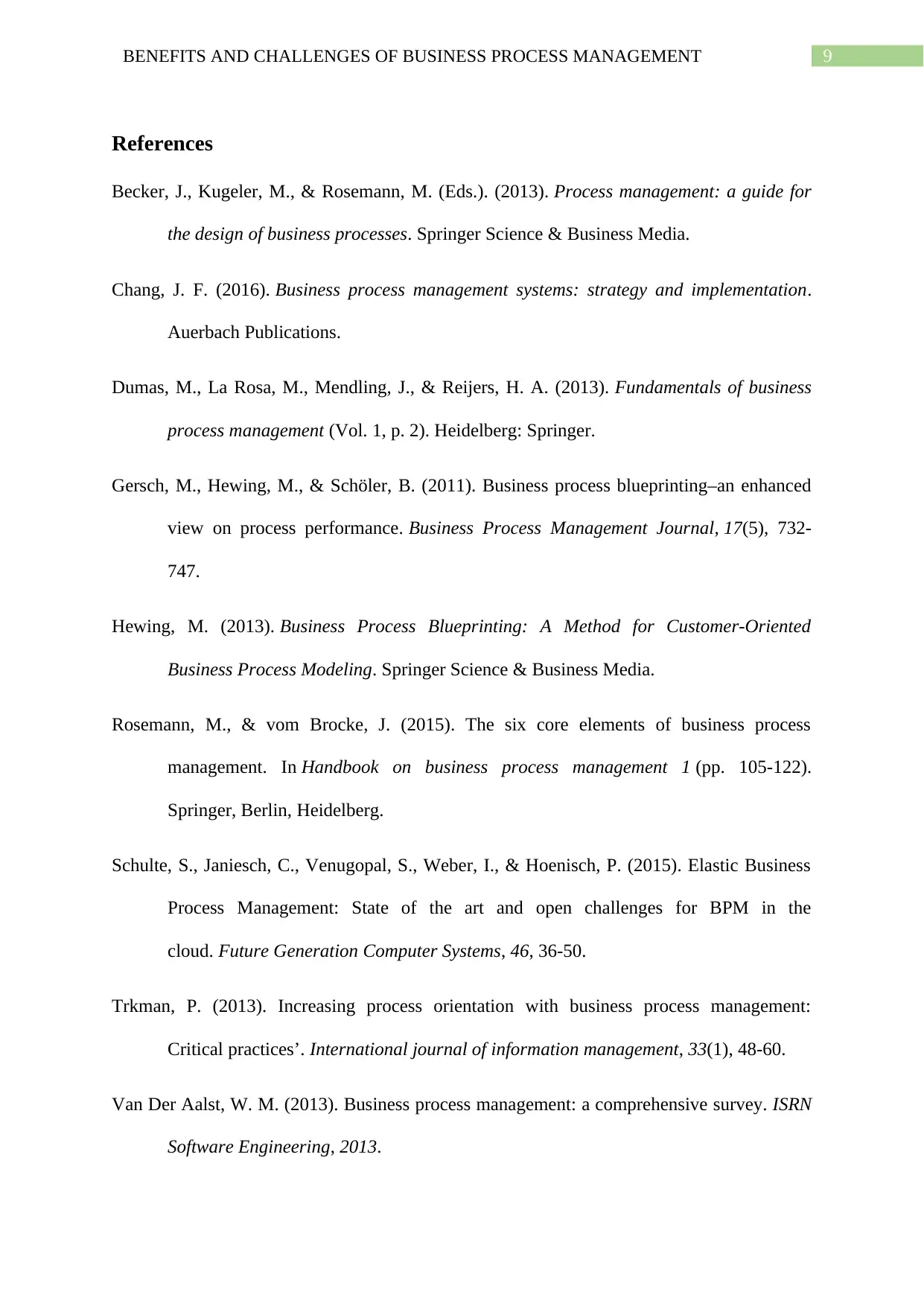
9BENEFITS AND CHALLENGES OF BUSINESS PROCESS MANAGEMENT
References
Becker, J., Kugeler, M., & Rosemann, M. (Eds.). (2013). Process management: a guide for
the design of business processes. Springer Science & Business Media.
Chang, J. F. (2016). Business process management systems: strategy and implementation.
Auerbach Publications.
Dumas, M., La Rosa, M., Mendling, J., & Reijers, H. A. (2013). Fundamentals of business
process management (Vol. 1, p. 2). Heidelberg: Springer.
Gersch, M., Hewing, M., & Schöler, B. (2011). Business process blueprinting–an enhanced
view on process performance. Business Process Management Journal, 17(5), 732-
747.
Hewing, M. (2013). Business Process Blueprinting: A Method for Customer-Oriented
Business Process Modeling. Springer Science & Business Media.
Rosemann, M., & vom Brocke, J. (2015). The six core elements of business process
management. In Handbook on business process management 1 (pp. 105-122).
Springer, Berlin, Heidelberg.
Schulte, S., Janiesch, C., Venugopal, S., Weber, I., & Hoenisch, P. (2015). Elastic Business
Process Management: State of the art and open challenges for BPM in the
cloud. Future Generation Computer Systems, 46, 36-50.
Trkman, P. (2013). Increasing process orientation with business process management:
Critical practices’. International journal of information management, 33(1), 48-60.
Van Der Aalst, W. M. (2013). Business process management: a comprehensive survey. ISRN
Software Engineering, 2013.
References
Becker, J., Kugeler, M., & Rosemann, M. (Eds.). (2013). Process management: a guide for
the design of business processes. Springer Science & Business Media.
Chang, J. F. (2016). Business process management systems: strategy and implementation.
Auerbach Publications.
Dumas, M., La Rosa, M., Mendling, J., & Reijers, H. A. (2013). Fundamentals of business
process management (Vol. 1, p. 2). Heidelberg: Springer.
Gersch, M., Hewing, M., & Schöler, B. (2011). Business process blueprinting–an enhanced
view on process performance. Business Process Management Journal, 17(5), 732-
747.
Hewing, M. (2013). Business Process Blueprinting: A Method for Customer-Oriented
Business Process Modeling. Springer Science & Business Media.
Rosemann, M., & vom Brocke, J. (2015). The six core elements of business process
management. In Handbook on business process management 1 (pp. 105-122).
Springer, Berlin, Heidelberg.
Schulte, S., Janiesch, C., Venugopal, S., Weber, I., & Hoenisch, P. (2015). Elastic Business
Process Management: State of the art and open challenges for BPM in the
cloud. Future Generation Computer Systems, 46, 36-50.
Trkman, P. (2013). Increasing process orientation with business process management:
Critical practices’. International journal of information management, 33(1), 48-60.
Van Der Aalst, W. M. (2013). Business process management: a comprehensive survey. ISRN
Software Engineering, 2013.
⊘ This is a preview!⊘
Do you want full access?
Subscribe today to unlock all pages.

Trusted by 1+ million students worldwide

10BENEFITS AND CHALLENGES OF BUSINESS PROCESS MANAGEMENT
Vom Brocke, J., Schmiedel, T., Recker, J., Trkman, P., Mertens, W., & Viaene, S. (2014).
Ten principles of good business process management. Business process management
journal, 20(4), 530-548.
Vom Brocke, J., Schmiedel, T., Recker, J., Trkman, P., Mertens, W., & Viaene, S. (2014).
Ten principles of good business process management. Business process management
journal, 20(4), 530-548.
1 out of 10
Related Documents
Your All-in-One AI-Powered Toolkit for Academic Success.
+13062052269
info@desklib.com
Available 24*7 on WhatsApp / Email
![[object Object]](/_next/static/media/star-bottom.7253800d.svg)
Unlock your academic potential
Copyright © 2020–2025 A2Z Services. All Rights Reserved. Developed and managed by ZUCOL.





